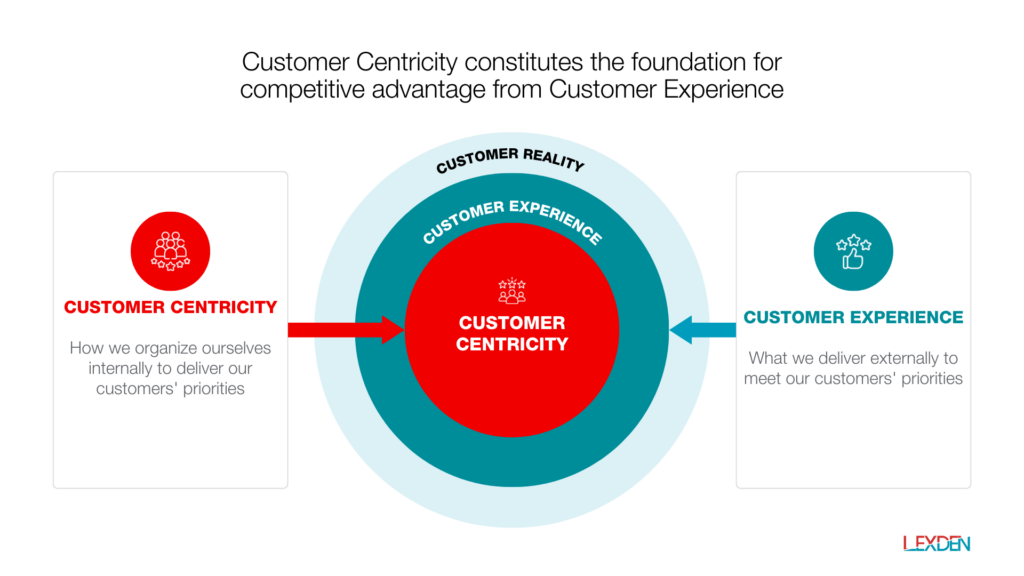This article on Customer Centricity is part of our ‘Back to Basics’ series.
In today’s fast-paced business landscape, customer-centricity has become more than just a buzzword; it is the cornerstone business practice for lasting success. As empowered consumers and digital transformation reshape industries, organisations increasingly prioritise their strategies around their customers’ needs and expectations.
In this article, we’ll explore the meaning of customer-centricity, its importance for businesses, and how to foster a customer-centric culture within your organisation.
What is Customer-Centricity?
At its core, customer-centricity refers to an organisational approach that places the customer closer to the centre of all business decisions. It entails a deep understanding of customers’ needs, preferences, and expectations, and aligning products, services, and experiences accordingly. Customer-centric organisations strive to build long-term relationships with their customers over transactional exchanges by consistently delivering exceptional value to their customers.
Annette Franz articulates in her book, Built to Win: “When your values drive a customer-centric culture, you’re putting customers at the centre of all you do – no discussions, decisions or designs without thinking about the customer.”
Without a customer-centric culture and embedded operating models to manage the process of keeping the customer central, an organisation cannot deliver effective customer experiences. Too often we see organisations design customer experiences to solve pain points (which are their own inadequacies) rather than achieve better outcomes (fulfil the motivations of the customer to choose the organisation over another).
It’s a belief that a relationship with the customer should not be solely transactional. Instead, by understanding the customer’s priorities, align the internal functions ways of working to recognise what matters to the customer and ensure these are embedded in how they do things.
Unless the internalised system of the organisation is aligned to customers’ behavioural drivers, decisions made will contradict with matters most to customers, resulting in experiences which may be functionally efficient for the organisation but will never emotionally connect with the customer. Creating memorable experiences forges a profound emotional bond between the customer and the brand. This bond, in turn, cultivates a more sustainable and valuable business in the long term.
Therefore, internal ways of working and culture within customer centricity influence, inform, and empower truly impactful and effective customer experiences.

The business case for customer-centricity
Customer-centricity is pivotal for businesses as it enables differentiation and fosters a sustainable competitive advantage. However, conflicting business-centric priorities often emerge. For example, in cost-cutting initiatives, functions might reduce customer service expenses without impacting revenue streams. Companies like Netflix and Amazon Prime have revamped customer experiences to streamline internal efficiencies—Netflix ceased account sharing, and Amazon Prime implemented return charges. Additionally, many organisations prioritise generating shareholder value, primarily focusing on short-term returns over investing in the 2 to 3-year establishment time frame required for robust customer-centric strategies. Choosing between immediate gains and long-term reliability in returns poses a challenge when considering the implementation of customer-centric approaches.
Businesses conventionally measure success through revenue and profit. Customer-centricity delivers more; such as employee contentment and improved social impact. As well as a reduction of reliance on marketing or customer service. All of which are challenging elements to contest when faced within the organisation are those whose existance depends on the failure of experiences to secure resources to compensate for it.
Improved Customer Satisfaction:
Customer-centric companies achieve higher levels of customer satisfaction. Research shows that they consistently outperform their peers by as much as 20% in customer satisfaction scores (McKinsey study). If satisfaction correlates to customer commitment, then it is a valuable measure to track. In some sectors, customer effort is a more informative measure letting the organisation know how easy it is to do business with them. If friction points can easily sway customers elsewhere a customer-centric focus on removing enough friction to be seen as effortless to work with is key.
Increased Customer Loyalty:
A customer-centric approach fosters loyalty and advocacy, thereby increasing customer retention. Research conducted by Temkin Group revealed that customer-centric organisations experience a 55% higher customer retention rate compared to their less customer-centric counterparts. Again, if the customers kept are those which value the relationship.
Improved Financial Performance:
Business generates profits through growth and productivity: customer-centricity directly impacts a company’s financial performance. According to a study conducted by Deloitte, customer-centric organisations were 60% more profitable compared to companies that did not prioritise their customers.
So where does that profit come from?
It’s important to remember customer-centricity creates the right environment for efficiency and effectiveness. It ensures the voice of the customer is heard, balanced against business priorities, and this voice feeds into the design of improved experiences. But it is not the hand that rewires an improved digital platform or trains a more empathetic call centre agent. The functions who delivered this previously continue to do so, just more effectively because their focus is on what matters to customers, and they have an appreciation of what customers expect from an outcome. This gain is the contribution from a customer-centric approach. But it is not something that can be easily extracted or benchmarked.
Employee Purpose
One of the less reported, but vital measures of customer-centric success is the impact on colleagues. Colleagues who have a purpose to create better outcomes for customers are more committed to a valuable cause. Studies commissioned by Lexden cited three crucial factors motivating colleagues to pursue a strategy:
- Believe the strategy will deliver profits for the business
- As a colleague, can see where personal contribution makes a difference
- Believe we are good at this
Customer centricity ensures the third important factor is positive for the customer.
Colleagues mention they considered leaving until they found a customer-focused purpose, an essential element in the customer-centric toolkit, ensuring continuity and momentum. Retaining these colleagues is a business case for customer centricity as they give so much to deliver the growth and productivity targets.
What is the essence of a customer-centric organisation?
A customer-centric organisation revolves around customer outcomes and aims to create a seamless and effective experience at every touchpoint. Such organisations prioritise the customer’s fulfilment and seek to achieve this in a way that reaffirm their brand distinction. They actively listen to their concerns, and use the insights gained to continuously improve their offerings. Customer-centric companies also foster a culture of curiosity, empathy, experimentation and sharing ensuring that every employee understands and values the importance of the customer and their connection to them,
Fostering a Customer-Centric Culture:
Building a customer-centric culture requires a collective effort from all employees. Here are some ways to cultivate a customer-centric mindset within your organisation:
- Leadership Commitment: Leaders must understand what customer-centricity can and can’t do. They must use the customer priorities as their currency too. A top exec can often tell you the previous quarters turnover. But can they tell you what matters most to customers and how the business fulfilled these drivers in new ways in the last quarter? Probably not.
- Employee Empowerment: Encourage and empower employees to make decisions that prioritise customer outcomes.
- Establishing a customer-centric operating model as a primary way of working. Without a process to listen, evaluate and prioritise the customer’s voice it won’t be heard in an authoritative way. And without a process to include it in the design and delivery of experiences it will not be aligned to customers’ expectations. And without a process to measure and recognise contribution, it will not be possible to recognise progress.
- Training and Development: Provide training programmes and the tool kit for customer centricity to equip employees with the necessary skills and knowledge to deliver exceptional customer experiences is essential.
- Celebrate Customer Success Stories: Highlight and share stories of exceptional customer service to inspire and motivate employees.
- Treat customer centricity as a leading business practice, in service of the customer.
Conclusion:
In an era of empowered customers, customer-centricity has become a prerequisite for business success. By making your customers’ outcomes part of your business strategy, you can build lasting relationships, foster loyalty, and achieve sustainable growth.
By adopting a customer-centric approach, businesses can differentiate themselves, and achieve higher customer satisfaction, loyalty, and financial success. Embracing customer-centricity is not just a strategy; it is a mindset that shapes the culture and fuels sustainable growth in today’s customer-driven market.
In the journey towards customer-centricity, it’s not just about the transactions; it’s about building trust and delivering exceptional experiences that keep customers coming back for more.
Embedding customer-centricity in your organisation is no mean feat. If you’d like to know where to start, please do get in touch as we’d love to help.
Exploring CX Essentials: Our ‘Back to Basics’ Series
Are you embarking on your Customer Experience (CX) journey? Welcome to our ‘Back to Basics’ series, designed specifically for newcomers. Amid CX’s diverse interpretations, we offer clarity based on solid experience. Our series is your reliable companion whether transitioning fields or seeking CX fundamentals. We present straightforward CX concepts, focusing on core principles. Join us in uncovering insights, dispelling myths, and navigating CX confidently. We’re here if you need an ally to guide you in this space.
Other Back to Basics:



